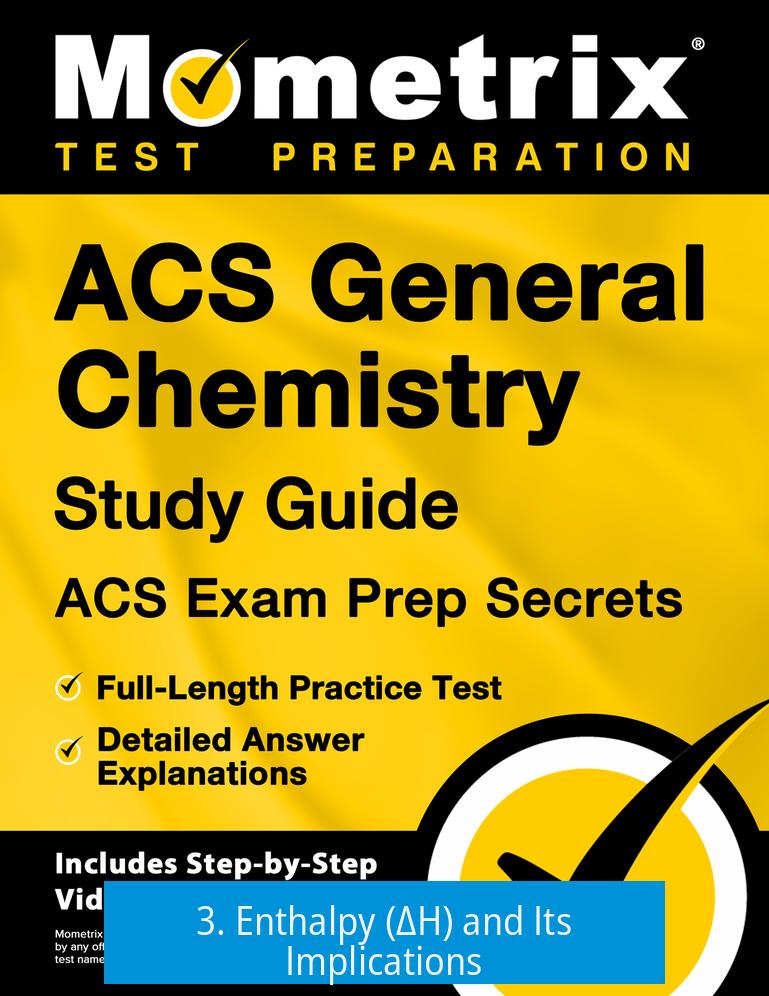What Should I Focus on for the ACS Physical Chemistry (PChem) Exam?

The ACS PChem exam demands strong mastery of thermodynamics, entropy, enthalpy, Gibbs free energy, activity concepts, quantum mechanics, and mathematical tools. By focusing on these key areas, students gain the best preparation for answering 30-35% of exam questions, particularly those involving ideal thermodynamic processes, spontaneity, and equilibrium.
1. Thermodynamics Under Ideal Conditions
A solid grasp of thermodynamic processes for ideal gases forms a cornerstone of the ACS PChem exam. Students should memorize and understand formulas for the four main process types:
- Isochoric Process (Constant Volume, ΔV = 0):
- Work done, w = 0
- Internal energy change, ΔU = q = (3/2) R n ΔT
- Enthalpy change, ΔH = ΔU + VΔP
- Isobaric Process (Constant Pressure, ΔP = 0):
- Heat, q = (5/2) R n ΔT
- Enthalpy change, ΔH = q
- Work, w = -P ΔV
- Internal energy change, ΔU = w + q
- Isothermal Process (Constant Temperature, ΔT = 0):
- Work done, w = -nRT ln(V2/V1) = nRT ln(P2/P1)
- Internal energy change, ΔU = 0
- Heat flow, q = -w
- Enthalpy change, ΔH = 0
- Adiabatic Process:
- Heat exchange, q = 0
- Work and internal energy changes follow from first law
Understanding cyclic processes is important: state functions like ΔH and ΔU for the full cycle equal zero.
These thermodynamics topics typically represent around 30-35% of the exam items. Some questions are straightforward; others involve nuanced application, especially related to work and heat calculations.
2. Entropy (S) and Its Role
Entropy is a key concept assessing spontaneity and phase behavior. Students should remember:
- Entropy is a state function.
- For spontaneous (irreversible) processes, ΔS_universe > 0. For reversible processes, ΔS_universe = 0.
- Entropy order: gases > liquids > solids.
- The formula for entropy change during isothermal expansion/compression: ΔS = n R ln(V2/V1).
- Relation of entropy to enthalpy of vaporization: ΔS = ΔH_vaporization / T. The sign of ΔH (endothermic or exothermic) directly affects ΔS.
Practice with entropy calculations in different processes aids solid understanding.
3. Enthalpy (ΔH) and Its Implications

Memorizing when enthalpy changes are positive or negative is critical:
- Endothermic reactions absorb heat and have ΔH > 0 (bond breaking).
- Exothermic reactions release heat and have ΔH < 0 (bond formation).
This knowledge assists in predicting reaction heat profiles and explaining energy flow in systems.
4. Gibbs Free Energy (ΔG) and Helmholtz Energy
Master equations related to Gibbs free energy:
- ΔG = ΔG° + RT ln Q, where Q is the reaction quotient.
- At equilibrium, ΔG = 0, so ΔG° = -RT ln K, which connects thermodynamics to equilibrium constants.
Students should understand differences between ΔG and ΔG°, and be ready to interpret related graphs.
Be familiar with vapor pressure and phase equilibrium equations such as:
- Clapeyron equation
- Clausius-Clapeyron equation
- Van’t Hoff equation
Practice interpreting these graphs and applying equations to phase transitions.
5. Activity and Activity Coefficients
Knowing activity concepts clarifies real solution behavior:
- Define activity and activity coefficients and understand their thermodynamic roles.
- For liquids, activity relates as a_liq = P/P°.
- For gases, activity is similarly a_gas = P/P°.
- Understand the relation between mole fractions and activity; pure liquids have activity = 1.
These distinctions are important for solution chemistry and equilibrium analysis.
6. Quantum Mechanics and Mathematical Foundations
The exam often includes quantum and mathematical components:
- Understand Hamiltonians and the Heisenberg uncertainty principle.
- Study particle-in-a-box models and all partition functions.
- Review calculus, linear algebra, and differential equations relevant to physical chemistry.
- Maxwell relations frequently appear—be able to derive and apply them.
Quantum concepts form a smaller, yet vital exam segment.
7. Practical Exam Tips and Additional Areas
Students with physics backgrounds tend to excel due to the test’s focus on PV=nRT relationships, adiabatic expansions, and thermodynamic calculations.
Remember to double-check all equations, signs, and unit conversions. Exam questions may vary in difficulty, so solid conceptual foundations help tackle novel problems effectively.
Practice graph reading skills for thermodynamic equations, such as Clapeyron and Van’t Hoff, to answer interpretive questions.
Key Takeaways
- Memorize thermodynamics formulas for ideal processes: isochoric, isobaric, isothermal, adiabatic.
- Master entropy concepts, especially entropy changes and their impact on spontaneity and phase transitions.
- Know signs and implications of enthalpy changes linked to bond breaking/forming.
- Understand Gibbs free energy equations, equilibrium relations, and related thermodynamic graphs.
- Learn definitions and applications for activity and activity coefficients in liquids and gases.
- Review Hamiltonians, partition functions, uncertainty principles, and Maxwell relations in quantum mechanics.
- Practice PV = nRT-related problems, especially adiabatic expansions.
What thermodynamics topics should I memorize for the ACS PChem exam?
Focus on ideal processes: isochoric, isobaric, isothermal, and adiabatic. Learn related formulas for work, heat, internal energy, and enthalpy. These form about 30-35% of the exam and save time if memorized.
How important is understanding entropy for the exam?
Entropy is key. Know it’s a state function, how it changes for different phases, and the entropy change formulas using q, T, and ideal gas relations. Spontaneity relates directly to entropy changes.
What should I know about Gibbs free energy on this test?
Understand ΔG = ΔG° + RTlnQ, equilibrium conditions, and the difference between ΔG and ΔG°. Be familiar with the Van’t Hoff and Clausius-Clapeyron equations and how they appear on graphs.
Are quantum mechanics topics tested on the ACS PChem exam?
Yes, expect questions on Hamiltonians, Heisenberg uncertainty, partition functions, and the particle in a box. Brush up on calculus, linear algebra, and differential equations basics too.
How should I approach activity and activity coefficients on the exam?
Know definitions and equations for activity in liquids and gases. Understand mole fractions, pure liquid activity (a=1), and the differences in equations between phases. This helps with equilibrium-related problems.
Is practicing PV=nRT and related expansions necessary?
Definitely. Be sure to review adiabatic expansions and other ideal gas behaviors. The exam often includes these topics, so strong familiarity is essential for answering those questions correctly.





Leave a Comment